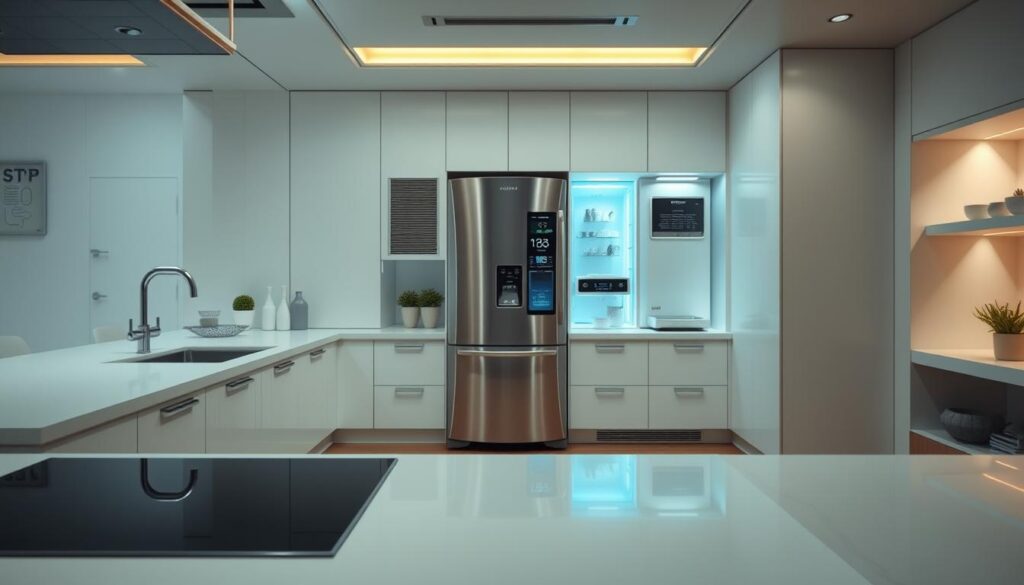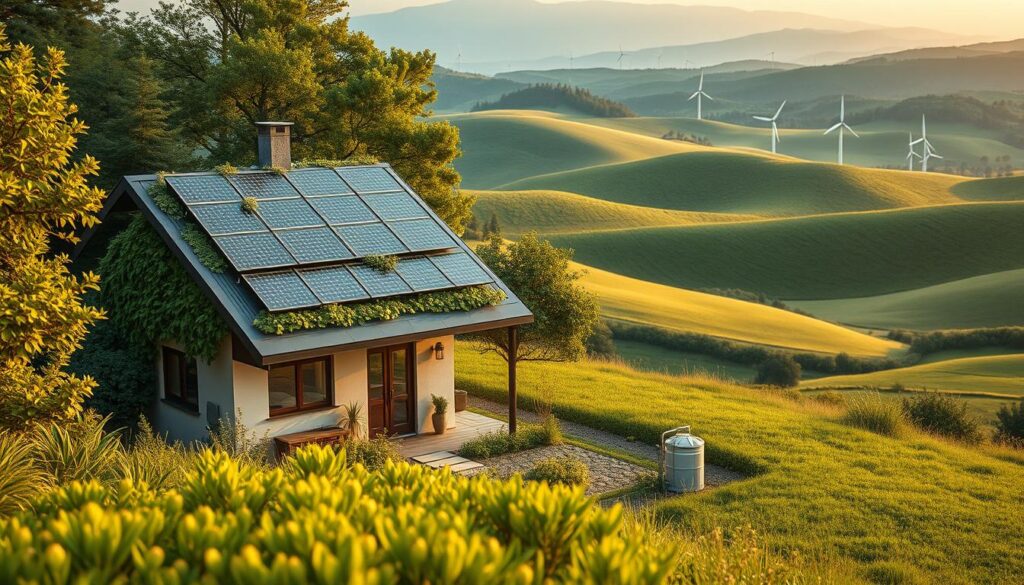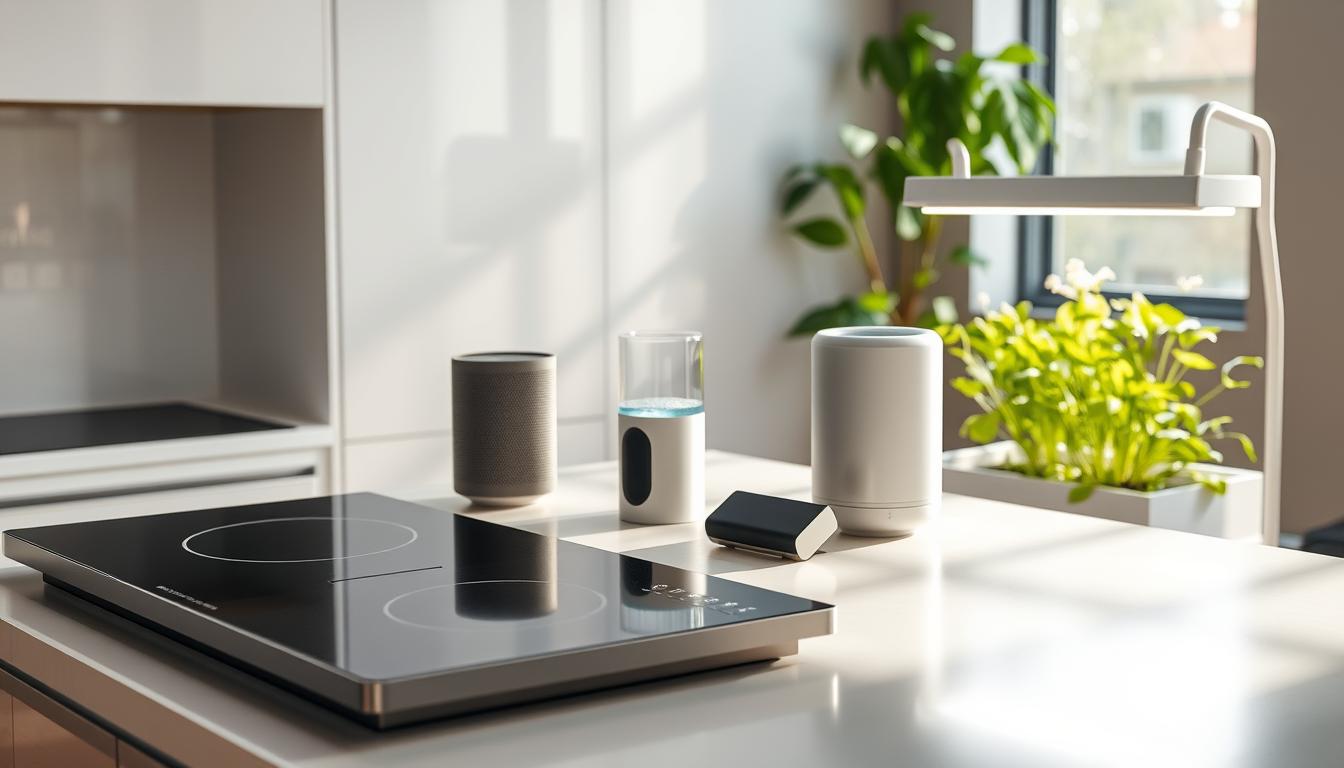Imagine a home where technology and sustainability work together to make daily life easier while protecting the planet. eco-friendly gadgets for home blend smart design with green principles, offering solutions like energy-saving smart bulbs or solar-powered chargers. These innovations prove that going green doesn’t mean sacrificing convenience.
From Nest Thermostats learning your schedule to Philips Hue lights dimming automatically, these devices cut waste without compromising comfort. Homeowners now choose appliances rated for energy efficiency, reducing bills and environmental impact. The shift reflects a growing demand for products that align with both modern living and ecological responsibility.
Key Takeaways
- Eco-friendly gadgets for home merge tech innovation with sustainability.
- Smart devices like thermostats and lights reduce energy use dramatically.
- Top brands focus on materials and energy efficiency for long-term benefits.
- Investing in these gadgets lowers utility costs over time.
- Modern homes prioritize style and sustainability in everyday appliances.
The Rise of Eco-friendly Gadgets in Modern Homes
Modern homes are shifting toward sustainable home products that blend style and planet care. These innovations address environmental concerns while enhancing daily life. From solar-powered chargers to smart thermostats, these gadgets prove eco-conscious choices don’t sacrifice convenience.
Benefits of Sustainable Tech
Switching to eco-friendly devices improves indoor air quality and reduces waste. Brands like Philips and Dyson now offer LED bulbs and air purifiers made with recycled materials. Such products cut pollution and inspire healthier lifestyles.
Impact on Energy Consumption
Energy-efficient appliances like LG’s ThinQ refrigerators use 40% less power than older models. Smart sensors in devices like Nest thermostats learn routines, trimming heating/cooling waste. Every kWh saved lowers utility costs and carbon footprints.
Long-term Cost Savings
- Initial setup costs often pay off within 2-5 years through energy bill reductions.
- Long-lasting materials in products like EcoFlow portable batteries reduce replacement frequency.
- Government rebates for solar panels or Energy Star-certified devices add immediate savings.
“Sustainable tech isn’t a trend—it’s a shift toward smarter living.”
Understanding Sustainable Home Technology
Sustainable home technology focuses on tools that reduce environmental impact while improving daily life. Green living gadgets achieve this by prioritizing efficiency and eco-conscious design. These innovations rethink how homes use energy, water, and materials.
- Energy Efficiency: Devices with solar charging or low-power modes.
- Recycled Materials: Built using bamboo, recycled plastic, or aluminum.
- Smart Integration: Apps that track usage and suggest eco-friendly habits.
| Traditional Materials | Sustainable Alternatives |
|---|---|
| Plastic casings | Bamboo or biodegradable composites |
| Single-use batteries | Rechargeable or solar-powered options |
| Non-recyclable packaging | Cardboard or mushroom-based biodegradable packing |
These gadgets matter because they cut waste and inspire mindful consumption. From smart thermostats to water-saving showerheads, they turn everyday tasks into eco-conscious actions. Choosing them means supporting a cleaner future without sacrificing convenience.
Features to Look for in Green Living Gadgets
Choosing the right environmentally friendly electronic devices starts with understanding their core features. These gadgets merge style with sustainability, making eco-conscious choices effortless. Here’s what to prioritize when shopping.
Innovative Designs
Look for innovative designs that maximize efficiency without sacrificing style. Philips’ LED panels, for instance, blend minimalist aesthetics with 80% energy savings. Multi-functional devices—like solar-powered speakers or all-in-one smart plugs—cut clutter and resource use. Compact shapes and modular components make these gadgets fit seamlessly into any space.
Smart Integration
Top models sync effortlessly with smart home ecosystems. Smart thermostats like Nest or Ecobee adapt to routines, reducing energy waste. Voice-controlled gadgets from brands like LG or Samsung let users manage settings hands-free. Wi-Fi compatibility and app-based controls ensure effortless updates to energy use.
Eco-friendly Materials
Materials matter. Brands like IKEA and Dell now use recycled aluminum, bamboo, or ocean plastic in devices. Biodegradable plastics in small appliances and metal alloys in electronics reduce landfill waste. Check for certifications like FSC-certified wood or the RoHS compliance label.
“Smart design and sustainable materials are the future of tech,” says the 2023 Green Tech Report, highlighting how these features cut carbon footprints by 30%.
Spotlight on Environmentally Friendly Electronic Devices
Modern eco-conscious home appliances blend innovation with sustainability, offering practical solutions for eco-minded households. Brands like LG, Samsung, and Dyson lead the way with products that cut energy use without sacrificing performance.
- LG’s ThinQ Smart冰箱 uses AI to optimize energy use, lowering bills while preserving food.
- Samsung’s EcoBubble洗衣机 cleans clothes at lower temps, saving water and energy.
- Dyson’s purifier+humidify暖风机 combines air purification with smart climate control, reducing reliance on separate heaters or AC units.

“Our appliances are designed to meet today’s needs without compromising future resources,” states Samsung’s 2023 Sustainability Report. This philosophy drives features like solar-powered sensors in some models that adjust lighting and irrigation automatically.
These devices prove that going green doesn’t mean sacrificing convenience. From voice-controlled LED bulbs that last decades to refrigerators with eco-modes, eco-conscious home appliances make sustainability effortless. Upgrading to these options supports both your home’s efficiency and the planet’s health. As technology advances, these examples set the stage for the next sections exploring their real-world impacts and comparisons.
How Eco-conscious Home Appliances Enhance Everyday Living
Energy-efficient home gadgets aren’t just for the environmentally conscious—they’re practical upgrades that simplify life. From smart thermostats that learn routines to motion-activated LED lights, these devices blend convenience with sustainability. They cut utility bills while making homes safer and easier to manage.
Optimizing Energy Use
Devices like Ecobee Smart Thermostats and Belkin WeMo outlets automatically adjust energy use. They track patterns and reduce waste without sacrificing comfort. Solar-powered phone chargers and Wi-Fi enabled plugs let users monitor consumption via apps, ensuring every watt counts.
Enhancing Home Safety
Smoke detectors from First Alert now pair with smart systems to alert users via phone if hazards arise. Leak sensors from Flume shut off water automatically, preventing damage. These gadgets combine environmental care with proactive protection, turning homes into safer spaces.
User-Friendly Experience
Apps like Google Home and Apple HomeKit let users control gadgets hands-free. Voice commands adjust lighting or turn off electronics, saving time and energy. Compact designs like portable air purifiers from Blueair fit anywhere, making eco-conscious choices effortless.
Comparing Energy-efficient Home Gadgets for Modern Lifestyles
Choosing the right eco-friendly smart home devices involves weighing how well they perform, their price, and their impact on the planet. This guide breaks down key factors to simplify your decision-making process.
Performance Metrics
Look for gadgets with high energy efficiency ratings. For instance, Nest Thermostats or Philips Hue Smart Bulbs offer measurable energy savings. Check compatibility with your existing smart home setup and ensure devices last long without frequent replacements.
Cost-Effectiveness
- Upfront costs vary, but eco-friendly smart home devices often pay off over time.
- Compare energy bills before and after installation.
- Government rebates or utility incentives can lower initial expenses.
Environmental Impact
Opt for products with certifications like Energy Star or carbon-neutral manufacturing. Brands like LG’s ThinQ or Samsung’s SmartThings highlight sustainability in materials and recycling programs. Prioritize devices designed for longevity to reduce e-waste.
Incorporating Eco-friendly Smart Home Devices into Your Daily Routine
Adopting green technology for homes starts with small, smart choices. Begin by identifying areas where energy is wasted—like leaving lights on or overheating rooms. Smart plugs and sensors automate adjustments, saving energy effortlessly. Pair devices like Nest thermostats or Philips Hue lights to sync with your habits.
- Set schedules for appliances to run during off-peak hours.
- Use voice-controlled assistants to manage energy use hands-free.
- Track consumption via apps to spot savings opportunities.
“Smart systems learn your routines, turning sustainability into second nature.”
Start with one device, like a solar-powered charger or an AI-powered water monitor. Gradually expand as you see results. Many brands offer free setup guides to simplify transitions. Integrating green technology for homes isn’t about overhauling your life—it’s about making choices that align with your lifestyle. Small steps today build a greener tomorrow, one smart decision at a time.
Exploring Green Technology for Homes: Innovations and Trends
Homeowners today are embracing eco-friendly home innovations that blend style with sustainability. From smart systems to renewable energy solutions, the market is buzzing with groundbreaking advancements. Let’s break down what’s new and what’s next.

Emerging technologies are reshaping how we live. Consider these前沿 trends:
- Solar-integrated building materials like Tesla’s Solar Roof tiles, which turn roofs into energy generators.
- AI-powered eco-friendly home innovations such as Ecobee’s smart thermostats that learn energy habits to cut waste.
- Water-saving devices, including Brac Systems’ shower tech that reduces usage without sacrificing performance.
Market trends show a surge in demand for carbon-neutral products. A 2023 study reveals 68% of U.S. buyers prioritize energy-efficient appliances. Brands like Philips and LG now offer LED lighting and refrigeration with 50% lower emissions than older models.
Looking ahead, here’s what’s in store:
- AI-driven climate control systems optimizing home energy use in real time.
- Net-zero home certifications becoming standard in new construction projects.
- Biodegradable materials replacing plastics in gadget components by 2025, per Green Tech Insights.
| Current Trends | Future Prospects |
|---|---|
| Solar panel subsidies | Wireless energy transmission |
| Smart irrigation systems | Carbon capture in HVAC units |
| LED lighting upgrades | Self-healing building materials |
These shifts mean more choices for eco-conscious households. As eco-friendly home innovations grow, they’re proving sustainability and convenience can go hand in hand.
Eco-friendly gadgets for home Buying Guide
Choosing the right sustainable living gadgets can feel overwhelming. This guide breaks down key steps to pick products that align with your eco-goals. Start by focusing on three main areas: features, brands, and feedback.
What to Consider
Look for these traits when shopping:
- Certifications like Energy Star or Cradle to Cradle
- Recyclable or modular design for easy upgrades
- Low-wattage operation and solar compatibility
Top Brands
Leading brands simplify the search:
| Brand | Key Features | Certifications |
|---|---|---|
| Philips Hue | Smart lighting with 95% recyclable parts | Energy Star, EU Ecolabel |
| EcoSmart Innovations | AI-powered thermostats reducing HVAC use by 30% | LEED, RoHS compliant |
| EcoTech Solutions | Water-saving showerheads with lifetime warranties | USDA BioPreferred, B Corp |
Customer Reviews
“The Philips Hue bulbs cut my energy bill by 25% in one month.” – Sarah M., verified buyer
Check review platforms like Amazon and GreenHomeReviews.com. Prioritize products with 4+ star ratings and at least 100 reviews. Look for comments about durability and ease of recycling.
Pair these tips with your budget and home needs. Small choices today create big impacts for sustainable living gadgets that last.
Conclusion
Eco-friendly gadgets and sustainable technology offer practical ways to reduce your environmental footprint while enhancing home life. From energy-efficient appliances like Philips Hue lighting to smart thermostats from Nest, these innovations cut costs and emissions. Choosing devices made with recycled materials, like those from Dyson or LG, supports a greener future without sacrificing convenience.
Starting small makes a big difference. Upgrading to energy-efficient appliances from brands like EcoSmart or Samsung can lower bills and inspire others. The shift to sustainable tech isn’t just about gadgets—it’s a lifestyle choice that aligns with global trends toward home sustainability.
Explore options like solar-powered chargers or water-saving smart systems from brands like LG and Samsung. Every choice matters, from smart sensors to energy monitors, building a home that’s both tech-savvy and planet-friendly. The future of home tech is here—embrace it today.
FAQ
What are some examples of eco-friendly gadgets for home?
Eco-friendly gadgets for home include solar-powered chargers, energy-efficient LED light bulbs, smart thermostats like the Nest Learning Thermostat, and water-saving showerheads. These devices help you minimize your environmental impact while enhancing your living space.
How do sustainable home products save money in the long run?
Sustainable home products often lead to significant long-term cost savings. For instance, energy-efficient appliances consume less energy, resulting in lower utility bills. Additionally, investing in high-quality green living gadgets can reduce maintenance costs and prolong the lifespan of your devices.
What features should I look for in environmentally friendly electronic devices?
When choosing environmentally friendly electronic devices, look for features such as certifications like ENERGY STAR, smart integration that optimizes energy use, innovative and eco-friendly materials in their construction, and user-friendly designs that enhance your daily experience.
How do eco-conscious home appliances enhance safety in the home?
Eco-conscious home appliances can enhance safety through smart technology that allows for real-time monitoring and alerts. For example, smart smoke detectors and security systems provide immediate notifications, ensuring that safety is prioritized while also being energy-efficient.
How can I incorporate eco-friendly smart home devices into my routine?
Consider starting with simple integrations, such as replacing traditional light bulbs with smart LED bulbs that can be controlled via an app. Gradually, you can add devices like smart plugs and energy monitoring systems, which help track your consumption and adjust usage patterns for improved sustainability.
What are the latest trends in green technology for homes?
Current trends in green technology for homes include advancements in solar technology, energy storage solutions like home batteries, and the development of smart home systems that improve energy efficiency. These innovations are paving the way for a more sustainable future in residential living.
Are there customer reviews for eco-friendly gadgets that I can check before buying?
Absolutely! Many websites and retailers provide customer reviews for eco-friendly gadgets and sustainable living gadgets. Checking these reviews can give you valuable insights into the performance, reliability, and user experience of various products from trusted brands.
